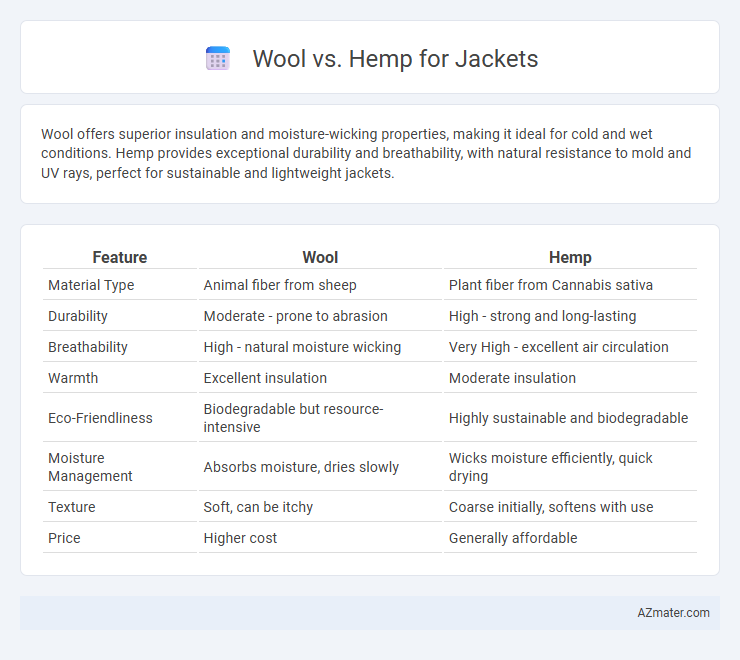Wool offers superior insulation and moisture-wicking properties, making it ideal for cold and wet conditions. Hemp provides exceptional durability and breathability, with natural resistance to mold and UV rays, perfect for sustainable and lightweight jackets.
Table of Comparison
| Feature | Wool | Hemp |
|---|---|---|
| Material Type | Animal fiber from sheep | Plant fiber from Cannabis sativa |
| Durability | Moderate - prone to abrasion | High - strong and long-lasting |
| Breathability | High - natural moisture wicking | Very High - excellent air circulation |
| Warmth | Excellent insulation | Moderate insulation |
| Eco-Friendliness | Biodegradable but resource-intensive | Highly sustainable and biodegradable |
| Moisture Management | Absorbs moisture, dries slowly | Wicks moisture efficiently, quick drying |
| Texture | Soft, can be itchy | Coarse initially, softens with use |
| Price | Higher cost | Generally affordable |
Introduction: Wool vs Hemp Jackets
Wool jackets offer superior insulation, moisture-wicking properties, and a natural ability to regulate temperature, making them ideal for cold and damp conditions. Hemp jackets provide excellent durability, breathability, and resistance to UV rays, suited for lightweight, sustainable outerwear. Comparing wool and hemp jackets reveals distinct benefits in warmth, environmental impact, and fabric strength for diverse climate needs.
Material Origins: Wool and Hemp Explained
Wool is derived from the fleece of sheep, making it a natural animal fiber with excellent insulation and moisture-wicking properties. Hemp originates from the stalks of the Cannabis sativa plant, offering a sustainable, breathable, and durable plant-based alternative. Both materials provide unique benefits in jacket production, with wool excelling in warmth and hemp standing out for its eco-friendly cultivation and resistance to wear.
Sustainability and Environmental Impact
Hemp jackets offer superior sustainability due to hemp's rapid growth and minimal need for pesticides or herbicides, significantly reducing environmental impact compared to wool. Wool production requires extensive land, water, and methane emissions from sheep, contributing to higher carbon footprints and resource depletion. Choosing hemp over wool supports eco-friendly fashion by promoting renewable, biodegradable fibers with lower greenhouse gas emissions.
Insulation and Warmth Comparison
Wool offers superior insulation and warmth due to its natural crimp, which traps heat effectively and regulates body temperature even when wet. Hemp, while durable and breathable, provides less thermal retention and is better suited for mild to moderate climates rather than extreme cold. Combining hemp with insulating layers or wool blends enhances jacket warmth while maintaining sustainability.
Breathability and Moisture Management
Wool excels in breathability and moisture management by naturally wicking moisture away from the skin while maintaining insulation even when damp, making it ideal for variable weather conditions. Hemp offers superior breathability due to its coarse fiber structure, allowing air to flow freely and drying quickly, which helps in hot and humid environments. Both fibers resist odor buildup, but wool's moisture-regulating properties provide better temperature control, whereas hemp's durability and quick-dry capabilities enhance comfort in active wear.
Durability and Wear Resistance
Hemp jackets offer exceptional durability and wear resistance due to the strong, fibrous structure of hemp fibers, which resist abrasion and pilling over time. Wool, while naturally elastic and insulating, may show signs of wear faster under heavy use, as prolonged friction can cause thinning and matting of the fibers. Hemp's resistance to UV damage and moisture also enhances its longevity compared to wool, making it a superior choice for rugged, long-lasting outerwear.
Comfort and Skin Sensitivity
Wool offers exceptional warmth and moisture-wicking properties, making it comfortable for cold weather but can sometimes cause irritation for sensitive skin due to lanolin. Hemp fabric is naturally hypoallergenic and breathable, providing a soft, non-irritating texture ideal for those with skin sensitivities. Both materials offer durability, but hemp's breathability and minimal itch factor often make it a preferred choice for comfort-conscious wearers.
Style, Texture, and Aesthetic Appeal
Wool jackets offer a classic, polished style with a soft, dense texture that provides warmth and a refined aesthetic, ideal for formal or traditional looks. Hemp jackets feature a coarser, natural texture that exudes an earthy, rustic charm, appealing to eco-conscious fashion with a breathable and durable fabric. Both materials deliver distinct visual and tactile experiences, with wool emphasizing elegance and hemp highlighting sustainability and ruggedness.
Maintenance and Care Tips
Wool jackets require gentle washing with cold water and mild detergent, avoiding excessive heat to prevent shrinking and pilling, while regular brushing helps maintain fiber loft and appearance. Hemp jackets benefit from being washed in cold water on a gentle cycle and air-dried to preserve fiber strength and reduce shrinkage, with occasional ironing to smooth wrinkles. Both fabrics respond well to spot cleaning and proper storage in a cool, dry place to extend jacket longevity and maintain fabric integrity.
Cost and Value Assessment
Wool jackets generally have a higher upfront cost due to the complex shearing and processing required, yet they offer superior warmth, moisture-wicking properties, and durability, enhancing long-term value. Hemp jackets tend to be more affordable, leveraging sustainable cultivation and fewer chemical inputs, while providing excellent breathability and natural antifungal qualities that add practical everyday wear benefits. Assessing cost against durability, comfort, and environmental impact positions wool as a premium investment and hemp as a cost-effective, eco-friendly alternative for outerwear.

Infographic: Wool vs Hemp for Jacket
 azmater.com
azmater.com